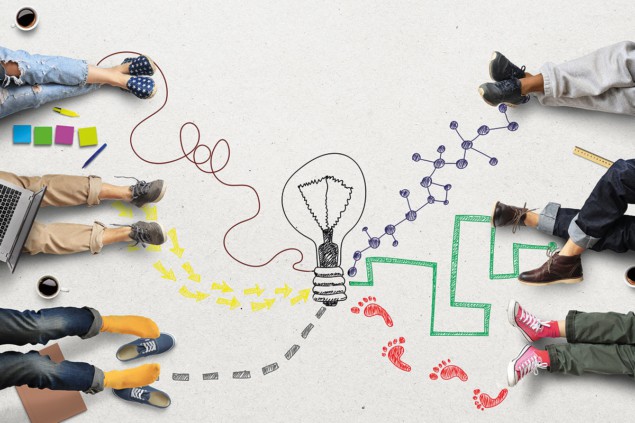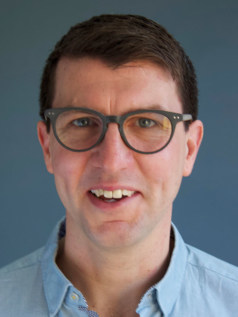Roland Harwood is a physicist who is fascinated by the art of open innovation. He tells Rachel Brazil how he has helped organizations ranging from Lego to the UN to implement change and why he believes that physics is leading the way when it comes to collaboration

Friends and colleagues have labelled Roland Harwood a “compulsive connector”. “[What] I spend a lot of my time doing is talking to people, connecting them with each other, connecting organizations with each other, and connecting old ideas to create new ones,” he says. Following a PhD in physics, Harwood has become an expert in the choreography of innovation. Now, as founder of the collective intelligence community, Liminal, he is looking to use these skills to support companies and public bodies in creating a more sustainable and equitable world.
Harwood grew up in Manchester, UK, and his natural abilities in maths and science led him to a physics degree at the University of Edinburgh. There he went to lectures by future Nobel laureate Peter Higgs, and remembers the occasions when Higgs mathematically derived Heisenberg’s uncertainty principle over a whole term. “It was, to this day, the hardest thing I’ve ever done intellectually,” says Harwood, and, although it was deeply satisfying, he also knew that this wasn’t his future.
A talented jazz pianist, Harwood initially became a musician and composer after graduating, but looking for more stability, he started an industry-sponsored PhD a year later at the University of Manchester, where he was able to pursue his growing interest in turning ideas into practical and commercial solutions. He worked on designing low-frequency ultrasonic imaging of high voltage switchgear for a consortium of electricity companies. The idea was to see if it was possible to re-purpose medical imaging technology to detect the type of insulation breakdown that causes failures.

For the next decade he went through a number of roles and eventually joined the London Development Agency, supporting and funding innovation. He started to get interested in just what holds good ideas back, and how we can create an infrastructure that allows people from different disciplines and sectors to collaborate.
In 2006 Harwood joined the National Endowment of Science, Technology and the Arts (NESTA) – then a public body set up to encourage new ways to innovate. Here he was able to put some of his ideas on connecting people, knowledge and organizations into practice, through a series of open innovation experiments. With some successes under his belt, his team became an independent open innovation agency, 100% Open.
Harwood says one of the biggest challenges in bringing groups together to innovate is always intellectual property (IP) – in particular, how do you stop big companies, deliberately or inadvertently stealing the IP of a small creative company or even academics. “But actually much more challenging than that was just culturally, opening up an organization to people outside it. In 2009, when we were starting up, [open innovation] was still quite new and counter-intuitive, and not the way most big organizations were geared. I think that’s changed,” says Harwood.
Building blocks
One of their most high profile projects, and the one of which he is most proud, was an open-innovation challenge launched with Lego, called Lego Ideas. Initially Lego’s more than 10,000 employees were invited to come up with ideas for new Lego sets, and those that gained wide support would be put into production. The programme, now run internally by the company, became open to all Lego customers. Typically, over a million people post ideas for new Lego products, the community votes on their favourites, and any that get to 10,000 votes are formally reviewed. For those ideas that become bona fide Lego products, 1% of the revenue gets shared with the creator. “It’s very commercially successful for Lego. It’s a brilliant way of unleashing their customers’ creativity and ideas and coming up with brand new things that they’ve never thought of,” says Harwood.

In 2018, after a decade with 100% Open, Harwood felt it was time to turn his attention to a different set of challenges. While open innovation was bearing fruit for many businesses, he wanted to use his skills to work on more socially driven problems, and particularly the innovation and change that is needed to deal with the climate crisis and the move to a carbon net-zero economy.
“I think learning to navigate transitions is a skill that we all need to work on individually, but also as organizations, as a society and the economy at large,” says Harwood, who has made this the focus of his new network Liminal. “I’ve been fascinated with the concept of liminality for many years – which means the grey area between more certain states.”
Liminal brings together about 120 “interesting, creative and entrepreneurial” people in a loose network to work with external organizations on creating the mechanisms for change within their establishments. Its first major project was with the United Nations and NESTA to develop a collective intelligence “playbook” – a series of methods for getting people to work together to solve problems.
The community is now also working with Hitachi on decarbonizing energy and transport networks. Hitachi is a huge company of 300,000 people and runs large portions of the world’s energy grid systems and freight movement logistics. It has committed to achieving carbon neutrality by 2050. Liminal has been helping them design processes needed for the transition to net zero, as well as developing a system to allow Hitachi customers to innovate and decarbonize.
The projects Liminal is taking on need a “high tolerance for ambiguity and uncertainty”, and Harwood says his PhD has prepared him well for this type of environment. He remembers struggling with the transition from being an undergraduate where the answers are at the back of the textbook, to a PhD, where your job is to figure out what the questions are and write the answers for others to learn from. “[My scientific training has] given me the confidence to embark on problems where I have no idea what the solution might be, or into spaces where it’s not even clear what the problem is that you’re solving, which is invaluable. Had I not done a PhD, I probably wouldn’t have had the confidence to embark on some of the things I do now.”
I think physicists and scientists understand that no-one can solve big fundamental scientific challenges on their own. You need to collaborate, you need to be open, you need to share
Harwood also thinks other sectors could learn from physics when it comes to collaborating. “Physicists and scientists understand that no-one can solve big fundamental scientific challenges on their own. You need to collaborate, you need to be open, you need to share. If you look at something like CERN, it’s a multinational, multilateral, highly collective endeavour. We need cooperation at that sort of scale, around climate [and] around other issues. Physics is ahead of the curve in working in this kind of way.”
We are clearly now in a time of change, which is the theme of Harwood’s podcast On The Edge. “I feel like the old certainties of technology, democracy and capitalism are breaking down and I think new ways of working, new ways of organizing, new ways of living are being experimented with,” he explains. At the moment he is happy to live with a level of uncertainty in the direction Liminal will take him, “I have no idea where it’s going. But I’m enjoying it for now.”


